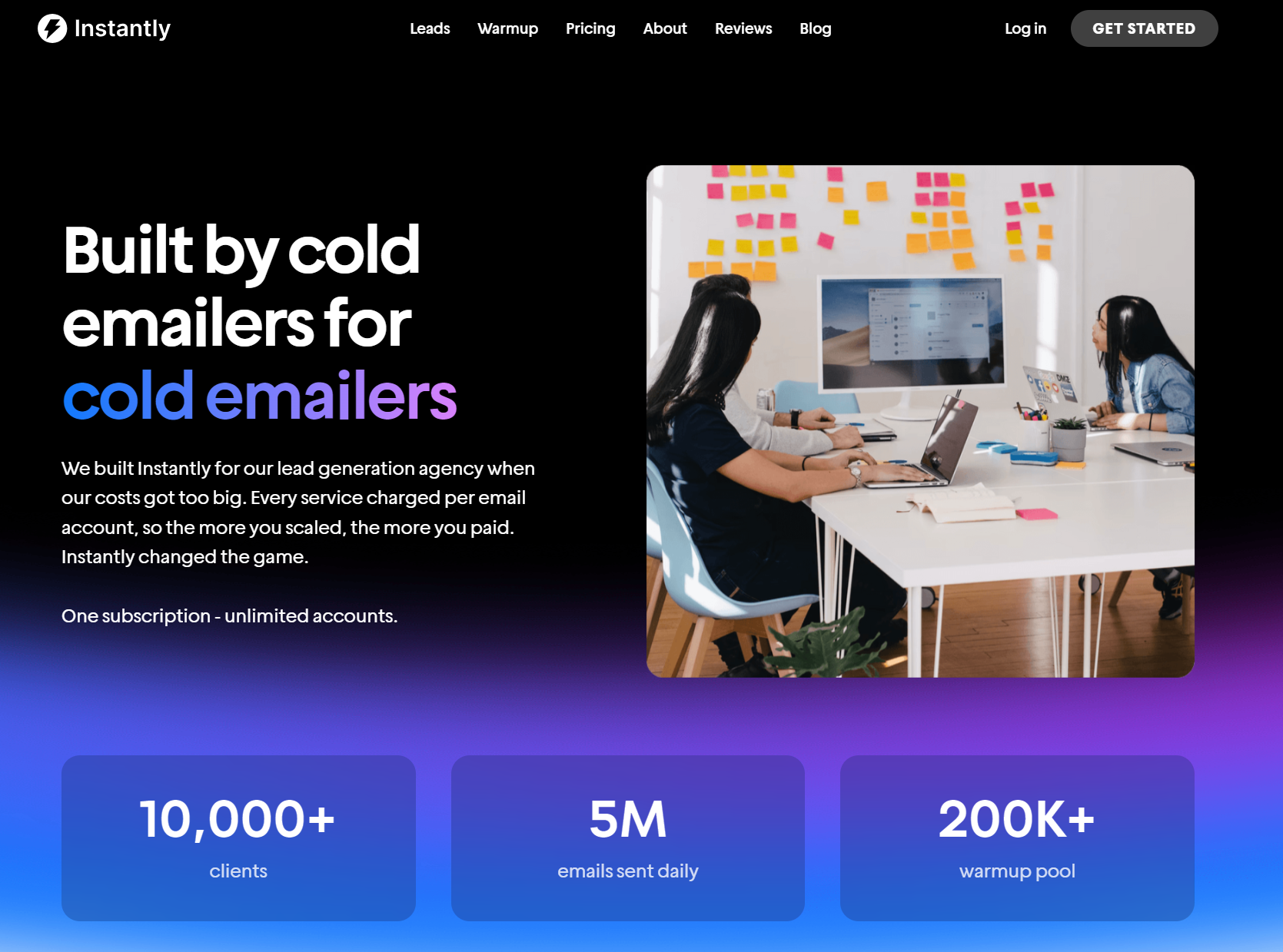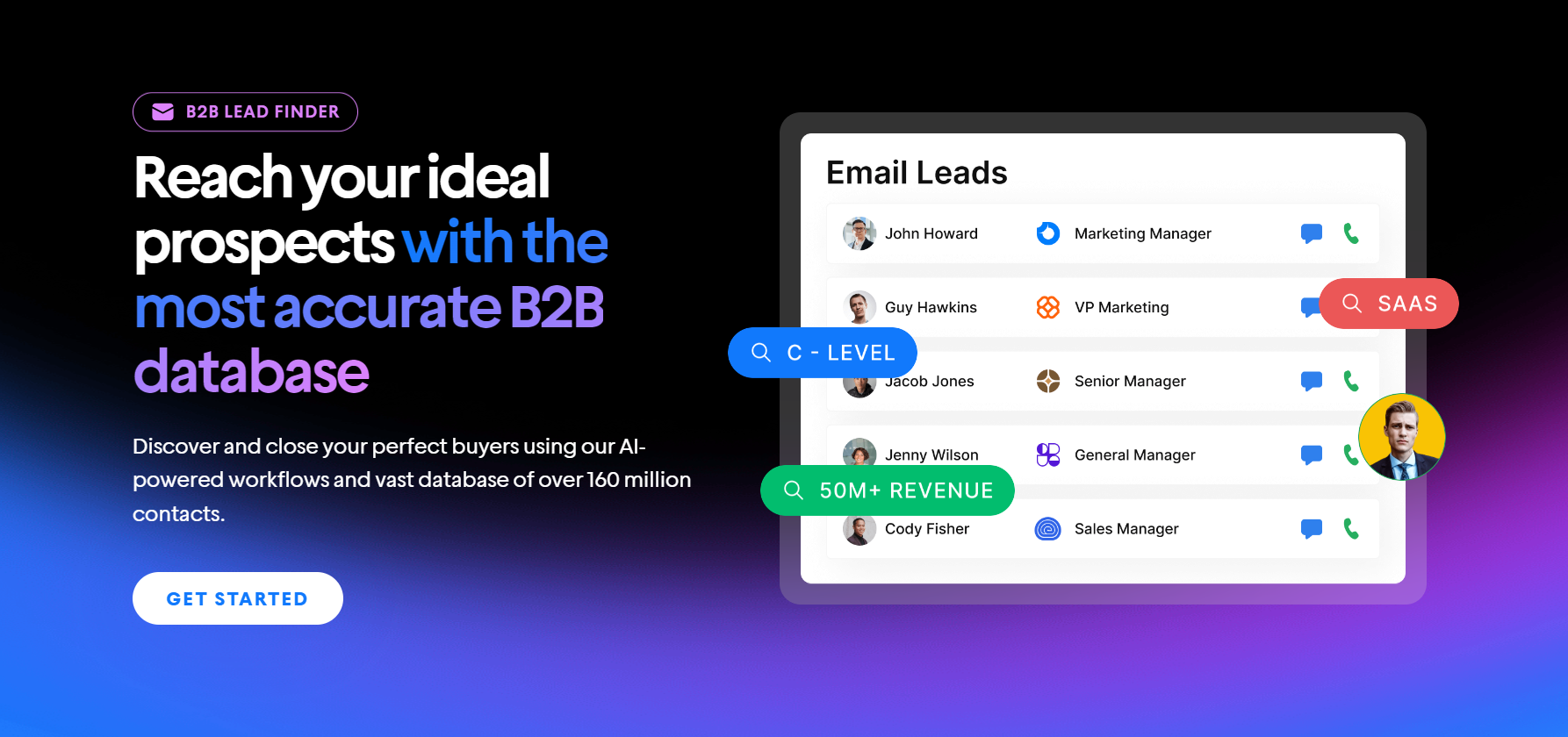In sales, opportunities don’t just fall into your lap—you need to find them. That’s what B2B sales prospecting is all about.
Prospecting means sorting through potential leads, zeroing in on the interested ones (and those who can buy), and reaching out to spark a conversation that could lead to a sale.
Sounds simple enough.
But the truth is that prospecting is a grind. It’s one of the most time-consuming but also one of the most critical parts of the sales process.
Even with fancy automation tools, success boils down to being intentional, strategic, and persistent in your efforts. We’re here to show you how to do just that. Let’s get prospecting.
Popular B2B Sales Prospecting Channels
Not all prospecting methods are created equal. What works best depends on your offer and target audience. Below, we’ll go over some of the most popular and effective strategies.
Cold Email Marketing
Cold email is one of the most tried-and-true methods for reaching potential clients. That’s because cold email prospecting is:
- Automatable: You can easily set up sequences to send emails at scale.
- Measurable: Metrics like open, click-through and reply rates help identify what works.
- Scalable: Cold email can work whether you send emails to 500 leads or 5,000.

But remember, cold email isn’t about volume. You can’t blast generic messages into the void and hope for the best. You need to be strategic.
Start with a high-quality list of prospects. Focus on decision-makers who align with your ideal customer profile (ICP) and buyer persona because bad data leads to wasted effort.
Craft irresistible subject lines. This is the first thing your prospect will see, so make it clear, intriguing, and specific enough to grab their attention. Personalization is also key.
To stand out, use the prospect’s name, mention their company, or mention something recent and relevant. Most importantly, focus on value.
Your email should center on how your product or service solves their problems or makes their life easier—not just what you’re selling. Finally, always include a clear call to action (CTA).
Don’t leave the recipient guessing what to do next; ask for a meeting, a quick call, or even just a reply, and make it simple for them to take the next step.
Cold Calling
Cold calling often gets a bad rap because of its intrusive nature. But when done right, it can be an effective way to connect with prospects. It’s all about preparation.
Before picking up the phone, research your prospect to tailor the conversation to their needs and challenges. Show you understand their business.
When you make the call, start with a strong opening. Grab their attention by introducing yourself, stating the reason for your call, and immediately delivering a hook relevant to them.
From there, focus on building a conversation, not just delivering a monologue. Ask open-ended questions to understand their pain points and goals, and actively listen to their responses.
Throughout the call, focus on your value. Communicate how your solution can address their problems or help them achieve their objectives.
Remember to close confidently. Whether scheduling a follow-up meeting or sending additional information, ensure a clear next step.
Social Selling (LinkedIn Prospecting)
Social selling works because you’re engaging with prospects on a platform they’re already on. For most B2B contexts, this means LinkedIn (or other professional social platform).
LinkedIn prospecting starts with creating a strong personal brand. If you send an invitation, the first thing prospects will do is check your profile.
Your profile should highlight expertise, credibility, and the value you bring. That means creating helpful content, answering questions, or starting live events like Webinars.
The key here is not just finding prospects but actively engaging with them. Follow them, interact with their content, and find opportunities for organic engagement.
Provide value first, sell last. This builds trust and positions you as someone who understands their needs. When the time is right, move from LinkedIn to more direct channels like email.
Referrals
Trust is a commodity in sales. That’s why referrals are so effective. Referral prospects will trust your brand more, because somebody they already trust vouches for you.
The key to a solid referral strategy is to ask the right people at the right time. Start by identifying happy customers who value your product or service they will most likely recommend you.
When you ask for a referral, make it easy for them. Be clear about who you want to connect with and why. Provide any materials or talking points they might need for the introduction.
Timing matters—reach out for referrals after delivering a win, like solving a big problem or completing a successful project. Don’t forget to show appreciation for their effort.
A simple thank-you, whether an email, a handwritten note, or even a small gesture like a gift card, goes a long way in encouraging future referrals.
If you’re in B2B SaaS, you could incentivize referrals by offering discounts or exclusive deals.
Events (Digital and Physical)
Whether digital or physical, events are great opportunities for prospecting because they bring you face-to-face (or screen-to-screen) with potential buyers in an engaged setting.
Preparation and follow-through are key to making events work. Before the event, research who will attend and identify key prospects you want to connect with.
For digital events, engage in discussions, join breakout rooms, or interact with speakers on social media. At physical events, be approachable, network intentionally, and have a few conversation starters ready.
Ask questions to learn about attendees’ challenges and goals, and listen carefully to understand how you might help. After the event, the real work begins.
Send follow-up emails while the interaction is still fresh. Write a thoughtful email referencing the event, including value or an invitation to chat more.
Best B2B Sales Prospecting Strategies
No matter which B2B sales prospecting channel or platform you choose, these actionable strategies ensure you’re making the most of your efforts.
Be Intentional With Your ICP
The common thread among all B2B sales prospecting channels is developing a solid ICP. It defines the type of company and decision-makers you should focus on.
Without a clear ICP, you risk wasting time and resources chasing leads that never convert. Or worse, you spend time on leads that don’t even have the authority to make a purchase.
Start by analyzing your existing customers. Who are your most successful clients? What industries are they in? What challenges do they face that your solution addresses?
Instantly B2B Finder lets you find prospects similar to your clients with the Lookalikes feature. You can also find your ICP with just a few clicks using advanced search filters.
Set Prospecting Goals
Clear goals keep prospecting efforts focused and measurable. Decide how many new leads you’ll target daily or weekly and define specific outcomes, like booked meetings or email responses.
Setting realistic KPIs ensures consistency and tracking progress over time. Whether you reach 50 prospects a week or book five meetings, having goals keeps you accountable and motivated. Remember: consistency beats sporadic effort every time.
Pre-Qualify Leads Before Outreach
Outreach efforts aim to qualify leads that match your ICP for sales. If they are qualified, account executives (AEs) take over. You can streamline this by pre-qualifying leads.
Tools like Instantly B2B Lead Finder let you run sales email campaigns on leads you know are qualified to purchase and have the means to do so. All you have to check for is interest.

Use Prospecting Tools
Lead finder tools are the cheat codes for B2B sales prospecting. The data is there, but you must focus on developing your ICP and buyer personas and verifying the email lists you get.
There are several tools available on the market. Ensure that you’re getting one with up-to-date and quality lead data. Then, use an email validation tool to check if lead lists have bad data.
If you want the process streamlined, try Instantly B2B Lead Finder. You only pay for pre-verified leads. Once you’ve built your list, you can immediately use it for any Instantly campaign.
Involve Multiple Stakeholders
Most businesses have multiple stakeholders, each with different criteria for solutions. While this might sound like more work, it presents an opportunity to get every stakeholder on board.
If you have a company contact list, you can segment it based on role. Each segment focuses on aspects of your offer that align with that segment's needs.
For example, the CEO can get an email about how your solution can improve revenue. Operations heads can get emails about how your solution helps efficiency and productivity.
Key Takeaways
B2B sales prospecting focuses on identifying and engaging the right leads to maximize efficiency and drive conversions. To make the most of your efforts, remember the following:
- Top Prospecting Channels: Cold emailing, cold calling, social selling on platforms like LinkedIn, referrals, and events are among the most effective methods.
- Key Strategies: Focus on building an ICP, setting clear prospecting goals, pre-qualifying leads, and using personalized outreach to drive engagement.
- Tools and Tech: Platforms like Instantly B2B Lead Finder streamline prospecting by offering pre-verified leads, email validation, and tools for creating tailored campaigns.
- Engage Stakeholders: Target multiple stakeholders within a business to address their specific pain points and align your solution with their unique needs.
- Consistency is Crucial: Prospecting success hinges on strategic, ongoing efforts—sporadic activity won’t deliver the same results.
Prospecting is all about finding the right people. Streamline and automate the process with Instantly B2B Lead Finder. Try it out for free today!





